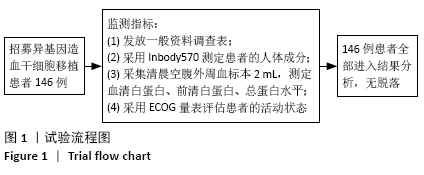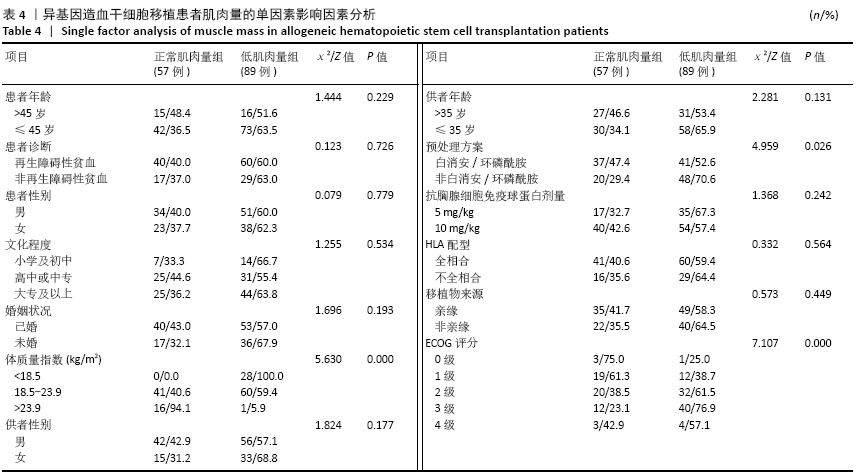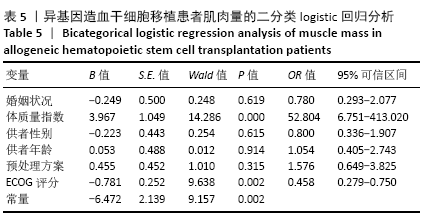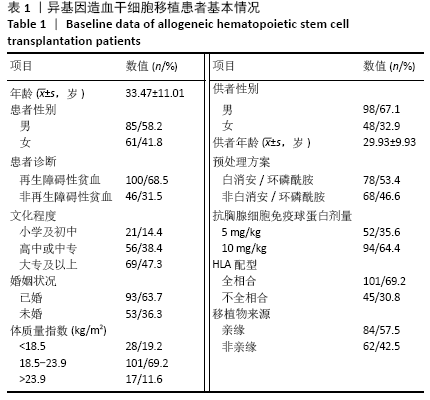中国组织工程研究 ›› 2021, Vol. 25 ›› Issue (13): 1999-2004.doi: 10.3969/j.issn.2095-4344.2197
• 造血干细胞 hematopoietic stem cells • 上一篇 下一篇
异基因造血干细胞移植患者的四肢肌肉量及影响因素调查
张文坚,马灵甫,王志敏,莫文健,周睿卿
- 广州市第一人民医院血液内科,广东省广州市 510180
Muscle mass evaluation and influencing factors of sarcopenia in allogeneic hematopoietic stem cell transplantation patients
Zhang Wenjian, Ma Lingfu, Wang Zhimin, Mo Wenjian, Zhou Ruiqing
- Department of Hematology, Guangzhou First People’s Hospital, Guangzhou 510180, Guangdong Province, China
摘要:
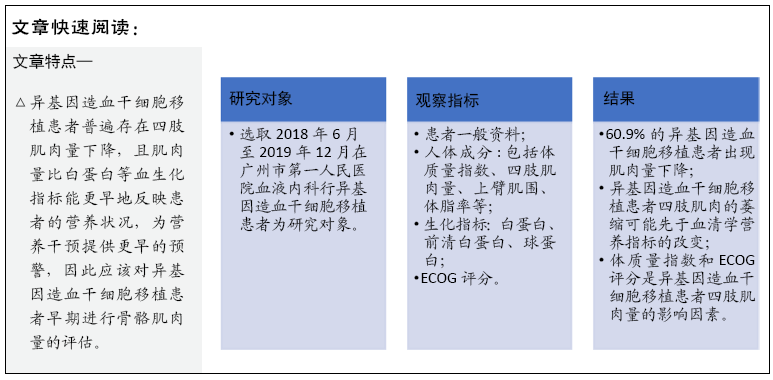 文题释义:
文题释义:
异基因造血干细胞移植:是将非同卵双生的其他人的造血干细胞移植到患者体内,起到造血或免疫重建作用的一种治疗手段,是目前治疗血液肿瘤、造血衰竭或免疫缺陷等血液疾病的重要方法。
肌少症:是一种与年龄相关的骨骼肌质量、力量降低和(或)伴有相关躯体功能丧失的临床综合征。肌少症的研究首先在老年人群中兴起,近年来在各种慢性疾病中逐渐得到关注。异基因造血干细胞移植患者移植后营养不良发生率高达66%,可能存在肌肉量下降。
背景:肌肉组织在完成运动、保持体位、维持机体内环境稳态等方面发挥着重要作用,肌肉量的评估和干预有助于提升患者生存质量、缩短住院时间,成为近年的研究热点。
目的:通过系统评估异基因造血干细胞移植患者的四肢肌肉量,探讨肌肉量下降的相关影响因素。
方法:选取行异基因造血干细胞移植的146例患者为研究对象,采用一般资料调查表收集研究对象年龄、性别、文化程度等,采用生物电阻抗法评估肌肉量,同时收集研究对象体质量指数、上臂肌围、三头肌皮褶厚度、体脂率、预处理方案、抗胸腺细胞免疫球蛋白剂量、HLA配型、移植物来源、白蛋白、前清白蛋白、总蛋白和ECOG评分。以四肢矫正肌肉量为因变量,行t 检验、卡方检验和二分类logistic回归分析。该研究通过广州市第一人民医院伦理委员会批准,所有患者同意参与此研究并签订知情同意书。
结果与结论:①89例(60.9%)异基因造血干细胞移植患者出现肌肉量下降,其中男51例,女38例;通过与中国正常人群参照值比较发现,异基因造血干细胞移植患者表现为更低水平的肌肉量、上臂肌围和三头肌皮褶厚度,但体脂率显著上升,差异有显著性意义(P < 0.05);②将患者分为低肌肉量组和正常肌肉量组,两组患者的体质量和体质量指数差异有显著性意义(P < 0.05),但血清白蛋白、前清白蛋白和总蛋白等生化指标差异无显著性意义(P > 0.05);③肌肉量单因素比较显示:体质量、体质量指数、预处理方案、ECOG评分差异有显著性意义(P < 0.05);二分类logistic回归发现高体质量指数为异基因造血干细胞移植患者肌肉量的保护因素(OR=52.804,P < 0.05),高ECOG评分为异基因造血干细胞移植患者肌肉量的危险因素(OR=0.458,P < 0.05);④结果表明,异基因造血干细胞移植患者普遍存在四肢肌肉量下降,且肌肉量比白蛋白等血生化指标能更早地反映患者的营养状况,为营养干预提供更早的预警,因此应该对异基因造血干细胞移植患者早期进行骨骼肌肉量的评估。
https://orcid.org/0000-0001-5462-612X(张文坚)
中国组织工程研究杂志出版内容重点:干细胞;骨髓干细胞;造血干细胞;脂肪干细胞;肿瘤干细胞;胚胎干细胞;脐带脐血干细胞;干细胞诱导;干细胞分化;组织工程
中图分类号:
